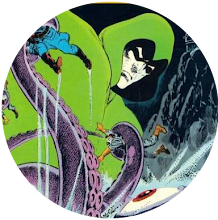It's not a simple choice. The Silver and Bronze Ages gave us a whole slew of classics. I love the first High Evolutionary story and the first Destroyer outing, not to mention the Wrecker's debut. There was Thor's first clash with Galactus and the first appearance of Ulik. Who could forget Ego, the living planet, or Hercules' descent into the Underworld?
From the John Buscema era there was the tale where Odin turned evil and thus became a slightly greater threat to the whole of existence than he normally was, and I do have a soft spot for the story where the Silver Surfer gets his board smashed by the Demolisher. Granted, that could owe more to my not being a fan of the Surfer rather than anything else.
But, no matter how hard I think about it, I can't get past one story and that's the four-part epic that is Mangog's first appearance. Mangog, a being of pure evil, made from the souls of a billion billion beings, a single-minded menace that didn't know how to take no for an answer.
The appeal of Mangog was obvious. Nothing could stop him. It was impossible to not be thrilled by the sight of him flinging storm giants around, smashing Asgardian legions and shrugging off Thor's mightiest blows like they were feathers.
If there are failings with the tale, for me, they're twofold. One is that, while Odin's in his Odin Sleep and Thor's busy trying to stop the monster, Loki finally gets his chance to claim the throne of Asgard but, having got it, shows no great interest in protecting it from the rampaging behemoth. I know Loki's supposed to be the God of Evil and therefore untrustworthy but it would've been nice if, once in power, like Dr Doom, he felt some urge to fight to preserve his kingdom.
The more damaging flaw was the resolution. In it, just as Mangog's about to draw the Odin Sword and destroy the universe, Odin finally condescends to wake from his Odin Sleep and deal with the menace. He does it with a ridiculous ease, simply willing Mangog out of existence with a casual wave of his sceptre. After all that battle, after all that strife, all that melodrama, it does feel like a total cheat for it to conclude so tamely and it brings home the problem of having a seemingly all-powerful character in the strip, a problem that meant contrivances like the Odin Sleep had to be invented to keep him away from the action.
Complaints about the resolution aside, the tale works because it's simply the ideal playpen for Jack Kirby to unleash his all-action style. Thor's battle with Mangog in issue #156 is simply awesome, as the thunder god throws everything he has at it and has any artist ever got more dynamism into his work than Kirby does for the following issue's assault on Asgard? Given such pictures, how could Stan Lee refuse to give us his finest hyperbole?
So there you have it. Action and hyperbole. In the end, what more could you want of a Thor story?










































































No comments:
Post a Comment